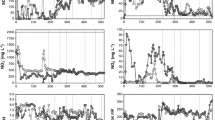Abstract
A mesophilic alkalitolerant aboriginal bacterial community capable of autotrophic thiocyanate decomposition under aerobic and oxygen-free conditions was isolated from reused water of a metallurgical works. The growth of the aboriginal bacterial community was optimal at pH 9.0. Ammonium and sulfate were the end products of thiocyanate decomposition under both aerobic and oxygen-free conditions. Under oxygen-free conditions, thiocyanate decomposition occurred in the presence of nitrate. Nitrite was accumulated as an intermediate product in the course of denitrification, and was subsequently used as an electron acceptor for thiocyanate oxidation. Dinitrogen was the end product of denitrification.
Similar content being viewed by others
References
Sorokin, D.Yu., Oxidation of Sulfur Compounds by Heterotrophic Microorganisms, Izv. Akad. Nauk SSSR, Ser. Biol., 1991, pp. 558–569.
Stafford, J., Dias, A.E.X.O., and Knowles, C.J., The Utilization of Thiocyanate as a Nitrogen Source by a Heterotrophic Bacterium: the Degradative Pathway Involves Formation of Ammonium and Tetrathionate, Microbiology (UK), 1994, vol. 140, pp. 2657–2662.
Grigor’eva, N.V., Kondrat’eva, T.F., Krasil’nikova, E.N., and Karavaiko, G.I., Mechanism of Cyanide and Thiocyanate Decomposition by an Association of Pseudomonas putida and Pseudomonas stutzeri Strains, Mikrobiologiya, 2006, vol. 75, no. 3, pp. 320–328 [Microbiology (Engl. Transl.), vol. 75, no. 3, pp. 266–273].
Happold, F.C., Jones, G.L., and Pratt, D.B., Utilization of Thiocyanate by Thiobacillus thioparus and T. thiocyanooxidans, Nature, 1958, vol. 182, pp. 266–267.
Katayama, Y. and Kuraishi, H., Characteristics of Thiobacillus thioparus and Its Thiocyanate Assimilation, Can. J. Microbiol., 1978, vol. 24, pp. 804–810.
Kim, S.-J. and Katayama, Y., Effect of Growth Conditions on Thiocyanate Degradation and Emission of Carbonyl Sulfide by Thiobacillus thioparus THI 115, Water Res., 2000, vol. 34, pp. 2887–2894.
Sorokin, D.Yu., Tourova, T.P., Lysenko, A.M., and Kuenen, J.G., Thioalkalivibrio tiocyanoxidans sp. nov. and Thioalkalivibrio paradoxus sp. nov. Novel Alkaliphilic, Obligately Autotrophic, Sulfur-Oxidizing Bacteria from Soda Lakes Capable of Growth on Thiocyanate, Int. J. Syst. Evol. Microbiol, 2002, vol. 52, pp. 657–664.
De Kruyff, C.D., van der Walt, J.I., and Schwartz, H.M., The Utilization of Thiocyanate and Nitrate by Thiobacilli, Antonie van Leeuwenhoek J. Microbiol. Serol., 1957, vol. 23, pp. 305–316.
Sokolova, G.A. and Karavaiko, G.I., Fiziologiya i geokhimicheskaya deyatel’nost’ tionovykh bakterii (Physiology and Geochemical Activity of Thiobacteria), Moscow: Nauka, 1964.
Sorokin, D.Yu., Tourova, T.P., Antipov, A.N., Muyzer, G., and Kuenen, J.G., Anaerobic Growth of the Haloalkaliphilic Denitrifying Sulfur-Oxidizing Bacterium Thioalcalivibrio tiocyanodenitrificans sp. nov. with Thiocyanate, Microbiology (UK), 2004, vol. 150, pp. 2435–2442.
Sörbo, B., A Colorimetric Determination of Thiosulfate, Biochim. Biophys. Acta, 1957, vol. 23, pp. 412–416.
Bhaudari, B. and Simlot, M.M., Rapid Micro-Method for Determination of Nitrate in Presence of Nitrite for Biochemical Studies, Indian J. Exper, 1986, vol. 24, pp. 223–327.
Lur’e, Yu.Yu., Unifitsirovannye metody analiza vod (Unified Methods of Water Analysis), Moscow: Khimiya, 1971.
Sorokin, D.Yu., Tourova, T.P., Lysenko, A.M., and Kuenen, J.G., Microbial Thiocyanate Utilization Under Highly Alkaline Conditions, Appl. Environ. Microbiol., 2001, vol. 67, pp. 528–538.
Author information
Authors and Affiliations
Corresponding author
Additional information
Original Russian Text © N.V. Grigor’eva, Yu.V. Smirnova, L.E. Dulov, 2009, published in Mikrobiologiya, 2009, Vol. 78, No. 4, pp. 451–455.
Rights and permissions
About this article
Cite this article
Grigor’eva, N.V., Smirnova, Y.V. & Dulov, L.E. Thiocyanate decomposition under aerobic and oxygen-free conditions by the aboriginal bacterial community isolated from the waste water of a metallurgical works. Microbiology 78, 402–406 (2009). https://doi.org/10.1134/S002626170904002X
Received:
Published:
Issue Date:
DOI: https://doi.org/10.1134/S002626170904002X



